2-Day Hakone Itinerary: Exploring Hakone, Mt. Fuji and Beyond

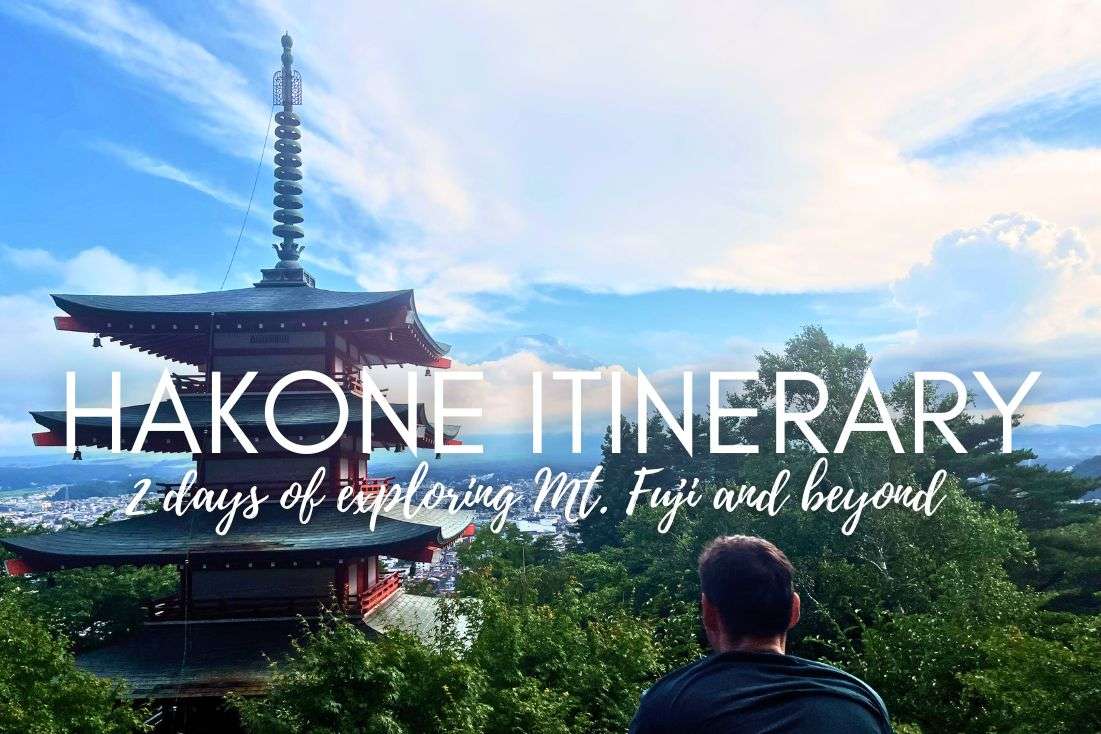
Overview of Hakone itinerary for 2 days + map
Day 1 of Hakone itinerary: Basically a Mt. Fuji itinerary
Where we stayed at Hakoe - How to save money
Day 2 of the Hakone itinerary: Hikes, volcanoes, and pirate ships
How many days do you need in Hakone?
Can you see Mt. Fuji from Hakone?
How long from Hakone to Mt. Fuji?
I put together this 2-day Hakone Itinerary after multiple visits over the years, and I consider Hakone one of the best places to visit in all of Japan and certainly the best for seeing Mt. Fuji.
For my first visit, I didn’t know much about Hakone, then it shot right to the top of any of my Japan itineraries because of its unique combination of brutally beautiful nature (imagine waterfalls such as Shiraito Falls, and mountains) and breathtaking views of Mount Fuji.
If you are traveling to Hakone as part of a 2-week Japan Itinerary, you can check mine.
Overview of Hakone itinerary for 2 days + map
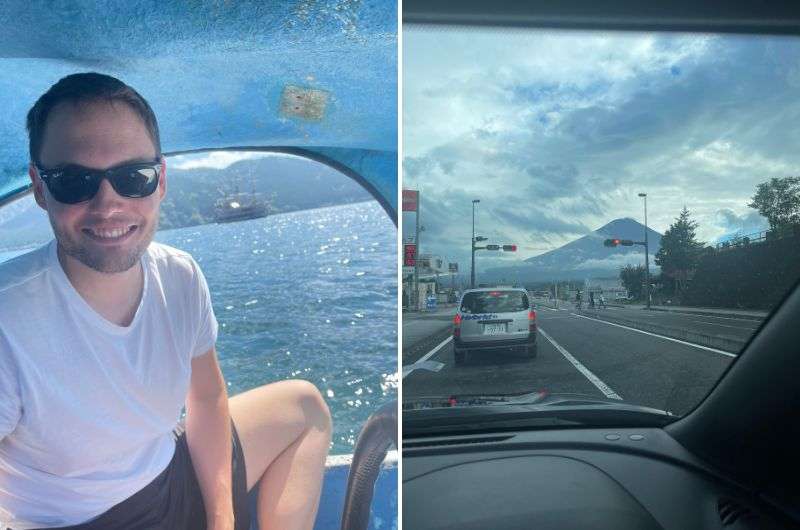
Hakone is a good base for your travel in Japan!
Here’s how to spend 2 days in Hakone and around Mt. Fuji:
Day 1: Lake Ashi, the Famous floating Red Torii Gate, Hakone Shrine, Komagatake Ropeway, Shiraito and Otodome Falls, Kitaguchi Shrine, Chureito Pagoda
Day 2: Mount Mitsutoge, Lake Ashi (pirate ship or garden), Owakudani
I chose to make Hakone our base because it’s a well-balanced option, as opposed to Kawaguchiko, which is a resort area to the northeast of Mt. Fuji that put me off by its overpriced accommodation. Even so, be ready to dish out for having the privilege to sleep so close to Japan’s tallest mountain!
Here’s a map of the Hakone area's top highlights:
For your own map of all of the attractions I’ve highlighted in Hakone and near Mt. Fuji, get my Google Maps list
What to Expect in my Itinerary
In this itinerary, I’ll give you a detailed trip plan for 2 full days from a base in Hakone—you’ll want to book a hotel for 3 nights. I have some tips on accommodation for you, too.
I’ve included travel times and distances, tips for parking and eating, and insights from my personal experience. And, at the very end of the article, the a popular FAQ section that should answer any lingering questions.
We drove this entire itinerary in our rental car, and I highly recommend you do, too, because you will be covering quite a lot of ground, and having your own set of wheels gives you infinite freedom. You’ll still be stuck on the road for hours, so you might as well do it on your own time.
Do you want to learn more about Japan? Read the whole Japan section.
Additionally, getting around the region to all of the highlights on this itinerary is next to impossible without a car. You’d need to take many buses with many transfers, spending more time on the road than at actual sightseeing spots.
How to get around Hakone
Traveling by Car
You absolutely should visit Hakone by car if you want to see everything in a meaningful amount of time, including all the natural attractions. If you're only interested in the city sights, public transport and walking will probably be enough, as the historical area is very walkable.
Parking lots are plentiful in the Hakone area, so you won’t encounter any problems, even during peak times. Heiwa no Torii, you should go there very early.
A note on the Hakone Free Pass
I found using Google Maps for public transport, especially in Kyoto and Tokyo, incredibly helpful, as the systems are well integrated with Google Maps. And since the Japanese are extremely punctual, you can just plug your route into Google Maps and you’re good to go.
The Hakone FreePass gives you unlimited transport use of Odakyu-affiliated transport services within the Hakone region, plus discounts at many of Hakone’s museums, restaurants, and parks. This includes free use of the Hakone Tozan Train, Hakone Ropeway, and even the sightseeing cruise on Lake Ashi (just the pirate one, not the other one).
The Hakone Free Pass is purchased for 2 or 3 days at any Odakayu train station, optionally also including a train trip from Tokyo’s Shinjuku Station. The price for a 2-day Hakone Free Pass is JPY 6,500 if bought in Tokyo (and including the trip to Hakone), JPY 5,000 if bought within the Hakone free zone. The 3-day tickets cost about JPY 400 more than the respective 2-day tickets.
Day 1 of Hakone itinerary: Basically a Mt. Fuji itinerary
A map of your driving route on day 1 of your Hakone itinerary. Get this route already planned in Google Maps
Main sites visited on day 1: Lake Ashi, Heiwa no Torii, Hakone Shrine, Komagatake Ropeway, Shiraito and Otodome Falls, Kitaguchi Shrine, Chureito Pagoda
Restaurant tips: Monta | Tokyo Sushi
Hotel recommendations: Hakone Retreat Före ($$)
Further reading: Things to do in Hakone
Let’s kick off our 2-day Hakone itinerary with a loop around the biggest (literally!) highlight of the region, Mt. Fuji. Even if you have the Hakone Free Pass, you’ll need a car for this itinerary; otherwise, you’ll spend half a day transferring between multiple buses. Free, but not fun.
As always, I like my days full of activities, so get up bright and early so you can make the most of your time in Hakone!
Day 1, stop 1: Lake Ashi and Hakone Jinja Shrine (Floating Red Torii Gate)
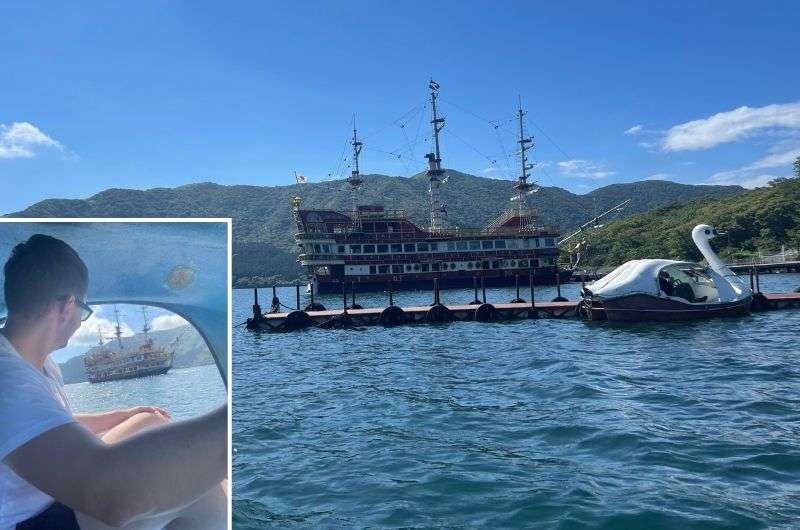
Swan cruise on Lake Ashi
Time spent there: 1 hour
Prices: Hakone Shrine is free, the swan boats are about USD 12 per 30 minutes
Begin your exploration of Hakone at Lake Ashinoko, a scenic spot known for its views of Mt. Fuji (you’ll need to make a pact with the weather gods, though), a peaceful atmosphere, and pirate ships? I’m not kidding, but we’ll get to that tomorrow.
How to Get to Hakone Jinja Shrine
Just hit Hakone Jinja Shrine on GPS and you are good to go. Word of warning though, go early as there is a limited number of parking spaces in the multilayered parking closeby (like hundreds of them), but the place was so busy I felt I went to Premium Outlets and was waiting for a parking spot once again.
What to Expect at the Famous Floating Red Torii Gate
You wouldn’t want to kick off your tour of one of Japan’s hotspots feeling like Captain Hook! So, let’s start with a torii gate on the water. How does that sound? Well, probably better than it is in reality!
Despite its picturesque setting, Heiwa no Torii, part of Hakone Shrine, is often a highlight for visitors of Lake Ashi, but it was a bit of a letdown for me. If you're expecting something out of a travel brochure, don’t. The torii is right by the shore! With a long line of selfie-hungry tourists, too. That is a no from me, but you do you?
Don’t forget the rest of the Hakone shrine as well
Instead, I recommend tucking further up into the Hakone Shrine complex. It's a lovely area in the forest with lantern-lined stairways and a peaceful vibe that makes you feel like you've stepped out of time. The further back up the old stairs you go, the better and more isolated it gets.
Going up to the shrine’s second and third levels means leaving behind most of the tourists near the water gate and having the place almost to yourself. Bliss!
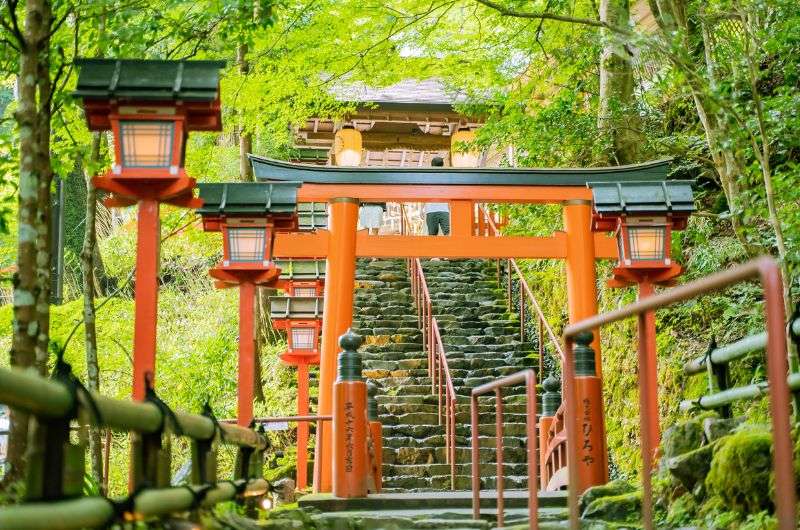
Hakone shrine complex
Extra Activity – Swan Pedal Boat
Extra activity: And then what did we do? Rented a swan pedal boat! You can’t miss them; there are several spots where you can get them. And it was good, albeit very slow, and fun.
You rent it by the half hour for something like USD 12, and off you go. Just so you know, swimming in Lake Ashi is forbidden because they fear you might get a heart attack because of how cold the water is. I certainly didn't want to try anyway.
Day 1, stop 2: Komagatake Ropeway (only in good weather)
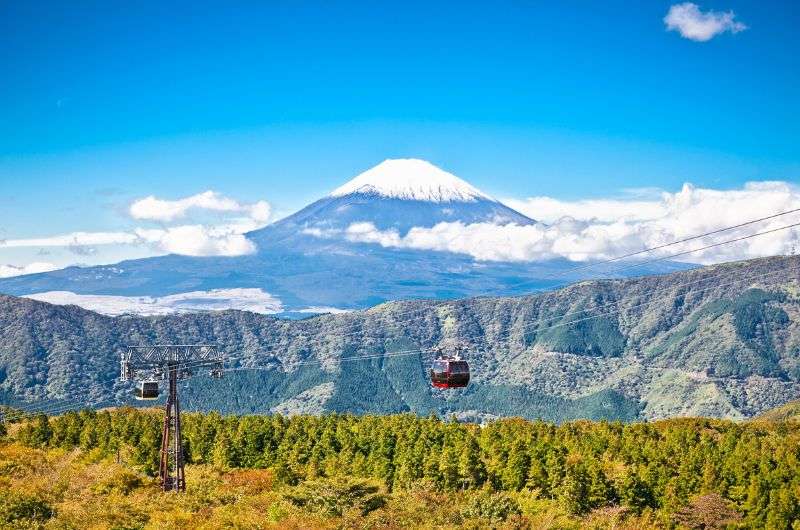
Komagatake Ropeway to enjoy the Mt. Fuji views
Distance from last stop: 2 km (1.2 mi), 5-minute drive
Time spent there: 45 minutes
Price: Round trip is JPY 1,800 (USD 12), Hakone Free Pass gets you a 10% discount
How to get to the Komagatake Ropeway
Stay at Lake Ashi, but move a little bit to the north, about 2 km (1.2 mi) from the underwhelming water torii of Hakone Shrine to the Komagatake Ropeway. If the sky is clear, it’s time for your first epic view of Mt. Fuji!
If it’s cloudy, skip this stop, because the views are literally the only thing interesting about the trip up Mount Komagatake.
Warning: Not to be confused with Hakone Ropeway! Be patient, you’ll get there too (tomorrow).
What to Expect at Komagatake Ropeway
The cable car is old, but it does the job. The large gondolas make their way up the mountain every 20 minutes or so, and the trip takes about 8 minutes. Up at the top, ignore the ugly cable car building and take in the views—you can see Lake Ashi and even the bay if it’s a clear day! And of course, the star of the show, Mt. Fuji, is lurking there in the distance.
View of Mt. Fuji
If you’re like me, you’ll be dumbfounded about how big Fuji really is! It’s massive! Mt. Fuji is Japan’s highest mountain at 3,776 m (12,390 ft) tall, and is, in fact, an active volcano. It’s been asleep, though, not spewing lava for about 300 years now. Let’s hope it doesn’t change its mind anytime soon.
Though you’d get more than your money’s worth if that happened while you were up on Mt. Komagatake. Now THAT would be some view.
Extra Activity
There’s also a short trail leading to a small shrine at the very tip of the mountain, which is also quite nice. Take the 10 minutes you need for that and head back down to Lake Ashi’s shore. Prepare for the next stop, Shiraito and Otodome Falls, where nature's beauty continues to unfold.
Day 1, stop 3: Shiraito and Otodome Falls
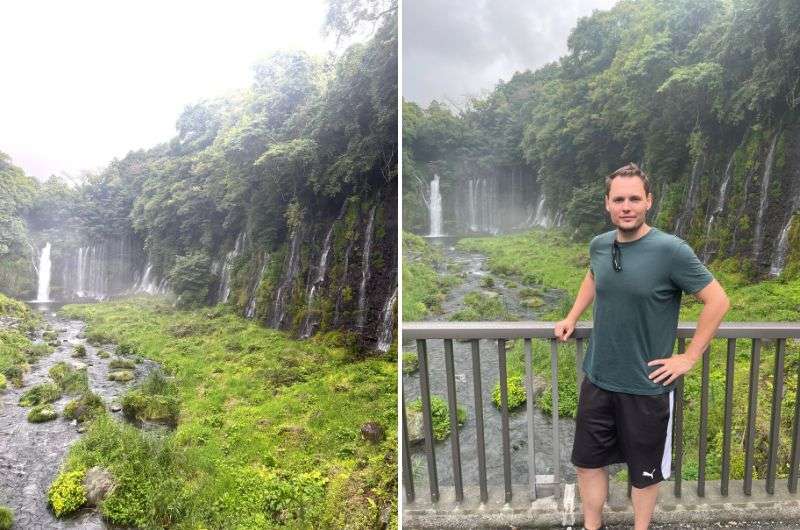
Shiraito and Otodome Falls
Distance from last stop: 65 km (40 mi), 1.5-hour drive
Time spent there: 1 hour
Price: Free unless we missed something
Japan gets a lot of rainfall (and Mt. Fuji gets a lot of snow that melts into water), which makes for some great water flow in the falls. There are well-maintained paths leading to both waterfalls, there’s no way to get lost, and they seemed to be suitable for pretty much everyone.
I must admit these falls are really nice, but they feel somehow smaller than those in Nikko – I just planned it in the wrong sequence.
How to get to Shiraito and Otodome Falls
From Moto-Hakone, the village where the Komagatake Ropeway is located, the drive to the waterfalls takes about 1.5 hours. There are a few parking lots around the entrance to the waterfalls, costing JPY 300–500 per vehicle.
What to Expect at Shiraito Falls and Otodome Falls
The Shiraito Falls is about 400 m from the main parking area, and it mesmerizes with water cascading from multiple sources. I loved how the water just bursts out of everywhere. Think of lots of narrow falls next to each other.
Otodome Falls, which you get to on the path in the opposite direction in about 200 m (there are signposts, don’t worry) impresses with its 25-meter drop. This waterfall is one big splash of water.
Quick Lunch at Shiraito Falls
Both waterfalls will take up about an hour of your time.
Hungry? There’s a little bistro called Shiraito General Store right by the main parking area that sells surprisingly good food (for a place on the parking lot of a touristy area). I’m talking real, hot meals, not just sandwiches. It’s also the first time I've seen cats in a stroller. Interesting.
Day 1, stop 4: Kitaguchi Shrine
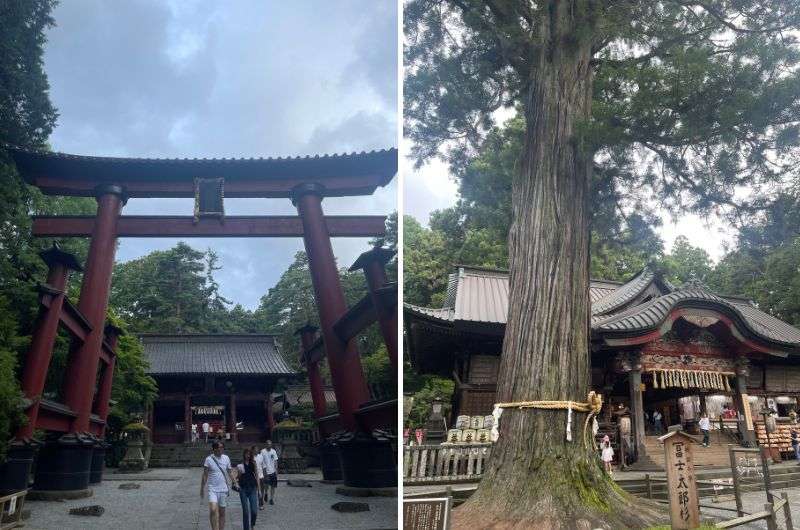
Kitaguchi Shrine won’t take you much time, but it’s definitely worth seeing!
Distance from last stop: 35 km (22 mi), 45-minute drive
Time spent there: 30 minutes
Price: Free entry
How to get to Kitaguchi Shrine
The drive to Kitaguchi Hongu Fuji Sengen Shrine from Shiraito and Otodome Falls takes about 45 minutes. You’ll be happy to get glimpses of Mt. Fuji on the way, which makes for an exhilarating game of peek-a-boo with the trees lining the road. There are parking lots at the entrance to Kitagushi Shrine. Just take your pick.
Why is Kitaguchi Shrine so special?
Honestly, guys, this might as well be a Mt. Fuji itinerary, because you’re circling that thing today like it’s nobody’s business! What’s more, Kitaguchi Hongu Fuji Sengen Shrine is of special Mt. Fuji importance: it was historically the starting point for Mt. Fuji hikers making the pilgrimage up the mountain. It’s like you’re at ground zero when you visit it.
It doesn’t hurt that Kitaguchi shrine is nestled amidst towering cedar trees that’ll have your eyes popping out and your neck hurting from looking up all the time. The grand torii gate is your gateway into a sacred space (even I almost felt it!), leading you down a path lined with ancient cedars.
Inside, discover the massive, 1000-year-old cedar trees, symbolizing the shrine's age and reverence. Notice how the trees have rope ties around them. I liked that detail a lot.
Behind the main hall, you can at least visit the wooden torii gate marking the start of the historic trail up Mt. Fuji. Even though you’re not climbing it from there (or anywhere, for that matter), it’s pretty cool to see and imagine what it would be like.
For me, the Kitaguchi shrine was mainly about those massive Cedar trees handcuffed by absolutely monstrous rope.
Fun Fact – Opening and Closing Mt. Fuji Ceremony
Even though nobody really climbs Mt. Fuji from Kitaguchi Shrine anymore, it is still the spot for the annual hiking season opening and closing ceremonies. On June 30th, a day ahead of the Fuji trails opening, the Kaizan-zenyasai festival is held.
A parade goes from Kanadorii Park to Kitaguchi Hongu Fuji Sengen Jinja Shrine, and a rope is cut to mark the beginning of hiking season. Then, on August 26th and 27th, the hiking season ends with the Yoshida Fire Festival. Imagine dozens of giant, 3 m (10 ft) torches burning away into the night—I haven’t seen it myself, but I imagine it’s magical!
Day 1, stop 5: Chureito Pagoda
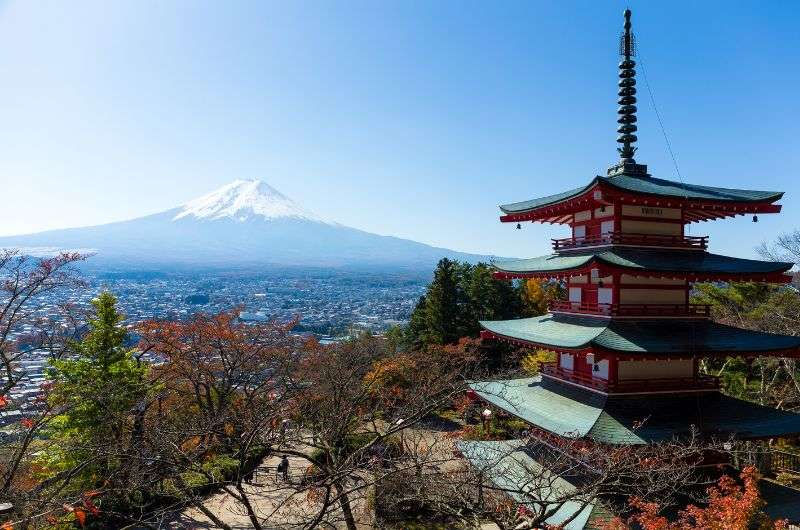
The iconic photo of Mt. Fuji and Chureito Pagoda
Distance from last stop: 5.5 km (3.5 mi), 15-minute drive
Time spent there: 20 minutes
Price: No entrance fee, no parking fee
How to get to Chureito Pagoda
Chureito Pagoda is just across Shimoyoshida city from Kitaguchi Shrine, so about a 15-minute drive. Easy peasy. Parking is plentiful and free. The Japanese really make visiting these top spots in the region super easy!
What to Expect at Chureito Pagoda
Views. I mean, this is the poster child of the whole Japan and Hakone area. We all saw the pictures before we went.
Chureito Pagoda is not about the pagoda at all, let’s be honest. Though I personally liked it, not blown away, but could appreciate it. But otherwise, people crowd here for that iconic photo with Fuji in the background. The pagoda is there for good photo composition, it’s just too bad nobody put a lake where the city is, it would’ve been the ultimate scenery upgrade!
Cherry on top warning: If you time your stop at Chureito Pagoda right, since this is your last stop before heading back to Hakone, you could see Mt. Fuji during sunset. How’s that for a pre-dinner show?
When you arrive at Chureito Pagoda, get ready to climb up 400 stairs from the parking lot to get to the viewing platform. Let’s say a 10-minute hike, 15 mins if you’re slow. There’s an alternative to stairs, which is a pathway that snakes up the mountain at a much gentler incline. It starts near the stairs, so take your pick.
I, a fit, handsome, charming 30-something, haven’t gone this slow way, so I can’t report on it. You know what they say: “Life’s short, take the stairs!”
How to take the best pictures of Fuji Mountain at Chureito Pagoda
• Don’t go in summer – I was there in summer and it is super cloudy
• Be super polite. Japanese are super polite and they will patiently wait for you to take as many pictures as you want.
• Make your space – don’t be afraid to tell other people to give you some space.
• Check the weather before you go. It's meaningless on a cloudy day.
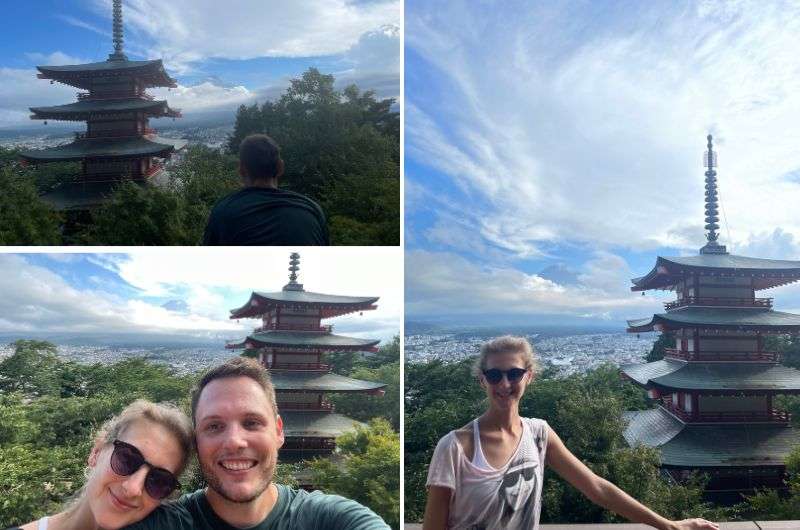
We tried so hard to capture Mt. Fuji... unsuccessfully. But we are beautiful!
Day 1 dinner: Monta
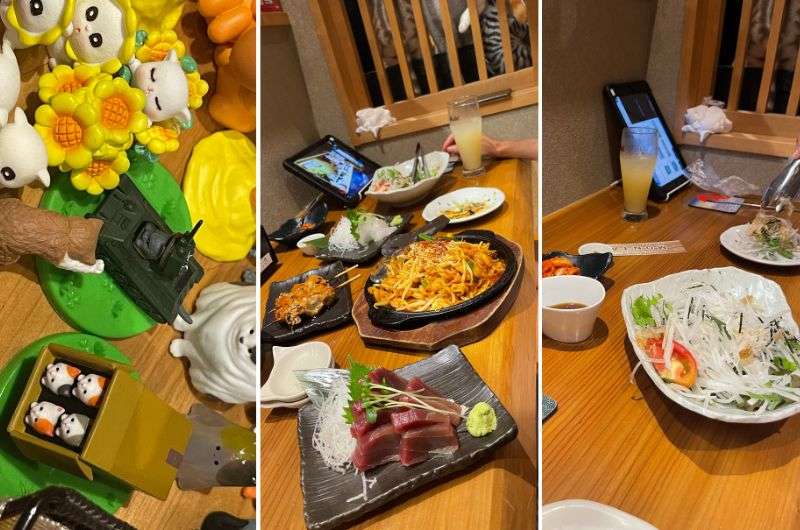
Monta Restaurant, “the one with all the cats”
The drive back to Hakone from Chureito Pagoda will take you around an hour, depending on where you’re staying.
You could, theoretically, head straight to Monta for dinner (don’t go there if you hate cats; there are cat toys and cat statues hilariously all over the place). It’s one of the top restaurants we tried the Japanese Cuisine in Hakone, and my girlfriend’s favorite restaurant in all of Japan. Or, if you’re staying at Hakone Retreat Före, you can easily pop into your room for a shower before heading out to dinner, because the hotel is just a hop and a skip away from Monta.
Story time: When we ate at Monta, we really ATE. You order your food on a tablet, so we clicked away at the tapas-sized meals, choosing about 10 things between the two of us. Seemed about right for the first round of ordering… Imagine our surprise when they started piling regular-sized portions onto the table. Of course, we didn’t want to be rude, and knowing the rules of Japan’s food culture, we started eating. And eating… until we could eat no more. But we ate it all and rolled away feeling like very stuffed champions.
Where we stayed at Hakoe - How to save money
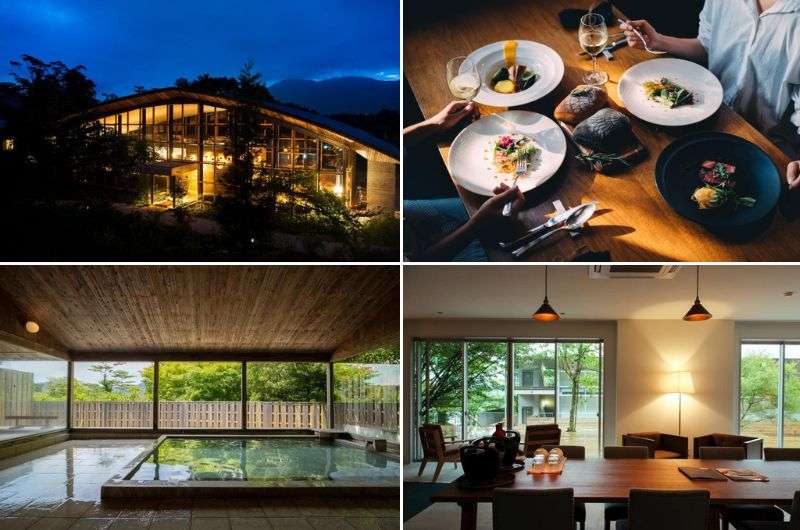
In Japan, you’ll quickly notice that hotels are on the expensive side. Generally, I paid USD 50 to 100 more per night to get the kind of standard I am used to. I guess the consolation prize is that eating out in restaurants is pretty cheap.
You can guess what the price point of hotels near Mt. Fuji is: outrageous! We chose Hakone not only for the many things to do in the area, but also because the hotels didn’t cost an arm and a leg… just a leg.
One thing to consider in Hakone is that it is onsen central, aka bathing in hot springs is the thing to do. Many hotels will have some sort of bath, either inside or outside, some even on your own private terrace. If this sounds like heaven to you, go for one of these three hotels with onsens in Hakone, with a strong preference for the first one:
Ryuguden ($$$) is the hotel to choose in Hakone! You’ll pay the price for it, though, especially for the rooms with a private hot spring bath. It’s on Lake Ashi’s shore, very close to the Komagatake ropeway, which is a bonus because that’s a fantastic location to be based for this Hakone itinerary. You’ll get views of the lake and the top of Mt. Fuji from some rooms and the onsen.
Day 2 of the Hakone itinerary: Hikes, volcanoes, and pirate ships
A map of your driving route on day 2 of your Hakone itinerary. Get this route already planned in Google Maps
Main sites visited on day 2: Mount Mitsutoge, Lake Ashi (pirate ship or garden), Owakudani
Restaurant tips: toe bar & restaurant for after your Mt. Mitsutoge hike | Tokyo Sushi for dinner in Hakone
Hotel recommendations: Hakone Retreat Före ($$)
Further reading: Japanese food culture and FAQs
Day 2, stop 1: Mount Mitsutoge Trail - Breathtaking views of Mount Fuji
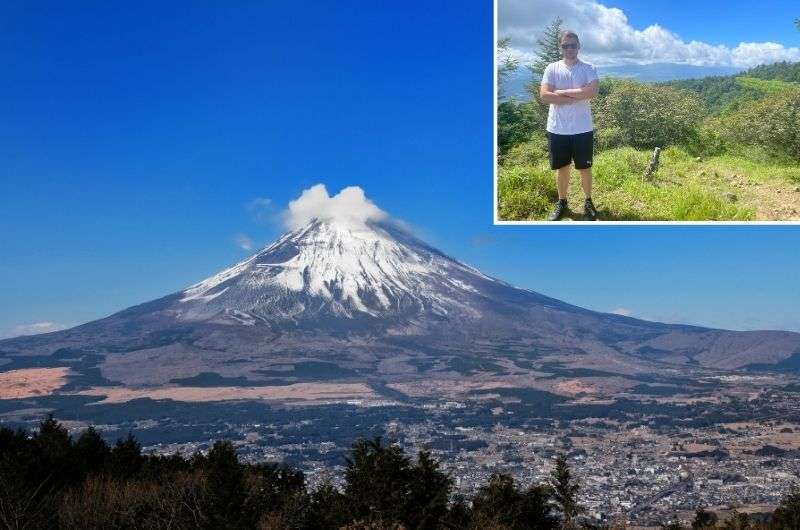
Take the Mount Mitsutoge hike to get the Mt. Fuji views!
Time spent there: 2–3.5 hours, depending on your hiking speed
This morning, you’ll drive back up to the northeastern “corner” of Mt. Fuji for a little hike that should give you some of the best views of Mt. Fuji you can muster up in such a short period of time. You’ll be climbing up Mt. Mitsutoge. The mountain has 3 peaks, but you’ll be happy with one, I presume.
The reason I chose the Mitsutoge hike is that hiking up Mt. Fuji is unnecessarily strenuous and takes 2 days, and, last but not least, because when you’re on Mt. Fuji, you can’t see Mt. Fuji. So we’re using Mitsutoge because it makes more sense in this regard.
Pro Tip: I learnt years ago that it is more enjoyable to see a pretty mountain, like Fuji, than climb it. You can't see it from climbing it. I also opt for about 66% of the height of the picturesque mountain, as you will get the best views.
There are several trails up Mt. Mitsutoge, and because we are very time-effective on this blog, we’re taking the shortest route up—we are climbing it mainly because of the Mt. Fuji views, after all.
The purple route is rarely mentioned on Mitsutoge hiking blogs, so you may be confused how we were at the summit in 1 hour when others take 6. It’s because of the purple route. On AllTrails, it’s called Mount Mitsutoge – Kanegakubo.
Mt. Mitsutoge Purple Trail details
Hike length: 6 km (3.7 miles) out-and-back
Elevation gain: 460 m (1,500 feet)
Difficulty level: Moderate
Hiking time: 2–3 hours
Parking and trailhead: Google Maps link
How to get to the Trailhead
You can park at the trailhead (or at another spot a little down the road in case this small lot is full) and start the hike from there. The trail takes you up Mt. Mitsutoge on a fairly steep forest dirt road. Not gonna lie, the views are obstructed by trees a lot of the way, and the journey up the mountain isn’t that amazing, so the destination is the destination this time.
Official time estimates say 2 hours to go up the mountain, but my girlfriend and I did the ascent in 55 minutes. Not to sound too cocky, but if you’re taking 2 hours to go up, maybe do some cardio now and then when you get back home?
What to Expect at the Mitsotuge Summit - The Best Views of Mount Fuji
From the Mitsutoge viewpoint, you're not just treated to Mt. Fuji's iconic silhouette; you get a panoramic view that includes the Southern Alps and Misaka Mountains. You’ll see peaks like Mt. Yatsugatake and Mt. Kitadake, but let's be real–Fuji takes the cake. If you can see the cake through the clouds.
I know I repeat my self a lot, but the clouds, man, they just get in the way at the most frustrating times!
Don’t be surprised that at the Mt. Mitsutoge viewpoint that it’s not a deserted natural wonderland. It’s a full-on picnic area with picnic tables, a cabin that serves as a guest house, and vending machines churning out Coca-Cola. Don’t expect to be served lunch, though, so pack your snacks with you.
Once you’re done taking in those hard-earned views, take the same route down, and you can drive back to Lake Ashi for some extra, lower-land Fuji viewing and some lake fun. Arrrrgh, you ready, matey?!
Day 2, stop 2: Cross Lake Ashi in a Pirate Ship (or garden with views)
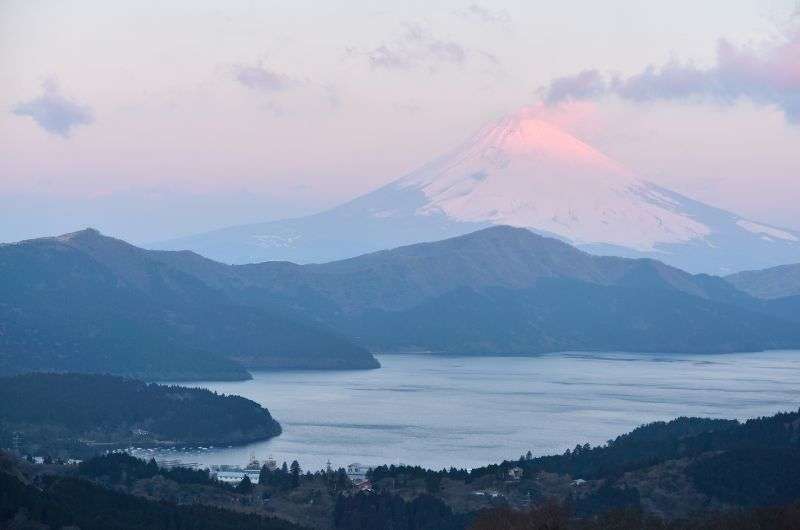
Lake Ashi from afar
Distance from last stop: 60 km (37 mi), 1.5-hour drive
Time spent there: 1 hour
Price: JPY 1000 one way or JPY 1850 return. Free with Hakone Free Pass (an extra fee applies if you want to travel in the luxury class)
Getting Back to Lake Ashinoko from Mt. Mitsotuge
You’ll head back to Lake Ashi from Mt. Mitsutoge, so expect about 1.5 hrs of driving. There’s a free parking lot that usually gets full before the ropeway starts going at 9 am, but you can try your luck. Otherwise, there’s a JPY 700 parking lot not far away, or just cough up the JPY 1000 parking lot right at the station.
Same lake, different area. This time around, park on the northern side of Lake Ashi, because the pirate ships are calling your name!
What to Expect from Lake Ashi Pirate Ships
Don’t try to find any logic behind why there are pirate ships on Lake Ashi—they just are, and it’s just so Japanese! They are tourist cruise ships that take you to the other side of the lake and back (or just one way, depending on you). Buy your ticket and line up, waiting for the next ship—they depart every 30 minutes or so.
One lake crossing takes about 20 minutes. A pirate ship tour on Lake Ashi is not something you can’t live without, but it’s fun and somehow has become one of the things to do on everyone’s Hakone itinerary. It’s either that or a swan pedal boat, but you’ve already conquered the water on those yesterday, right?
Choosing the Deck on a Pirate Ship
Tip: You can get first-class tickets for just an extra fee that are worth it, especially in worse weather conditions where you’ll appreciate having your own couch.
In the economy, you’re not guaranteed a seat, so it’s a mad dash once the gate opens. In first class, you get a seat (though not an assigned one, but at least you’ll have a spot), and everyone gets better views because you are up front.
That said, the best views will be on the top deck, standing by the railing. Look out for the view of Heiwa no Torii and Mt. Fuji. If you get to see Fuji, make the most of it, because it’s not visible the entire time as it hides behind the mountains for about 10 minutes. If the weather is not on your side and it happens to be cloudy, windy, and/or rainy, just stay inside the ship, Captain Hook.
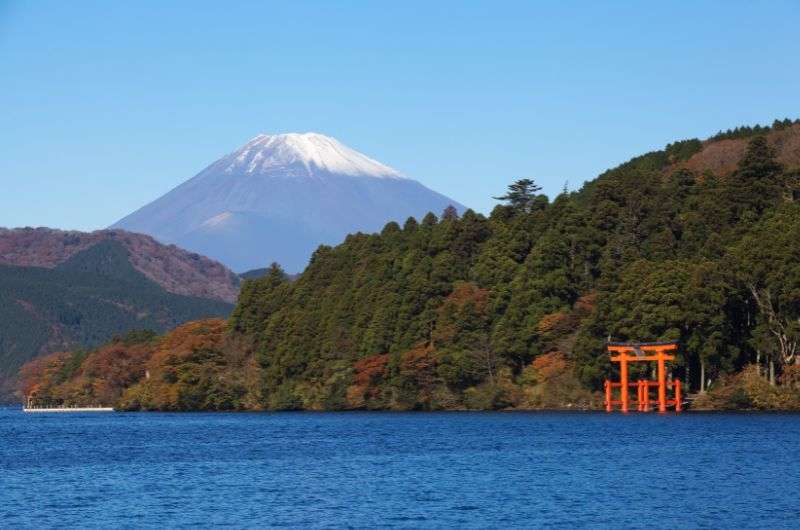
Mt. Fuji and Heiwa no Tori
Alternative - Onshi-Hakone Park
Also, if any kind of ship makes you yawn (or seasick), you can also enjoy a little extra outdoor time on dry land at Onshi-Hakone Park on the lake's southern edge. There are a couple of trails and even an observation deck, but it's a gamble whether Mount Fuji will grace you with its presence.
The Japanese garden architecture is always something that calms even the fidgetiest souls, myself included. Make sure to take the 200 old, stone stairs up to the higher section where you can get cool views of the lake at the observation deck. Overall, it‘s a nice walk, and not that many people make their way to the park, especially when compared to the crowds playing pirates.
Day 2, stop 3: Owakudani and Hakone Ropeway
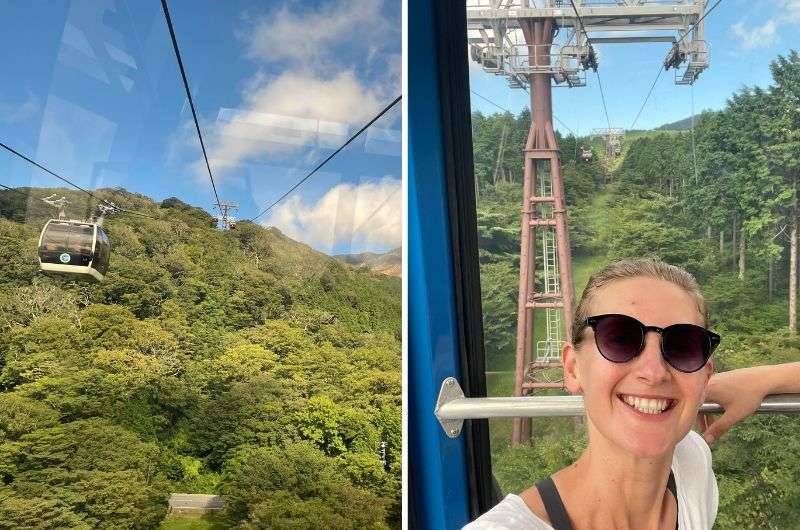
Get the nice views from Hakone Ropeway
Distance from last stop: No distance from the pirate boats, the ropeway is right by the Togendai Pier
Time spent there: 2 hours
Price: JPY 2500 for round-trip Hakone Ropeway ticket, free with Hakone Free Pass
If you are near the northern pirate ship port, you’re also near the Hakone Ropeway. If not, make your way back up to the north to Togendai Station so you can hit the skies on this next stop of your itinerary… and check out some impressive volcanic landscapes at Owakudani!
Expect Queues - You can't win on the way up to Owakudani Station
You have two choices to get to Owakudani Station: the Hakone Ropeway, which is a must-do thing in Hakone, or driving. If you can imagine your life without a cable car ride, I’m here to tell you that driving’s also a good option to get to Owakudani, despite Google Maps telling you there’s a traffic jam.
It’s not lying, there really is a traffic jam, but on them again, there’s a 100% chance of a long line of people waiting for the ropeway, too, and it can be very long.
The Gondola from Hakone
In the end, I have to say that the ropeway was worth it for the views, even if the queues tested my patience. There’s a never-ending supply of 18-person gondolas that keep coming every minute or so, but they need to speed those babies up if they are going to keep up with the demand!
A full trip on the Hakone Ropeway takes a little over half an hour. Owakudani is about at the halfway point, so expect a 20-minute trip soaring through the sky with views of the valley below.
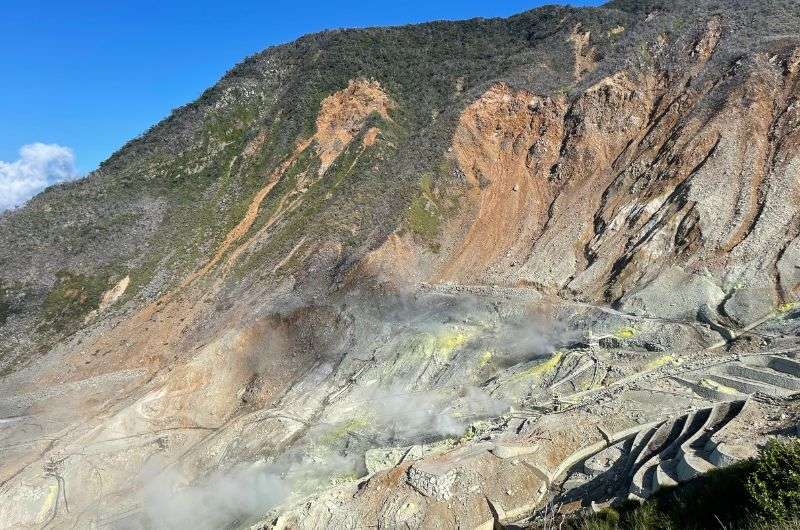
The Owakudani volcano
Owakudani and Black Eggs
At Owakudani, there are trails around the smelly vents and views of Mount Hakone, which’ll take you about 30 minutes to navigate, and the geomuseum was a real eye-opener. It's packed with info, mainly in Japanese, but you’ll still be able to grasp the main info. The topographic map of Hakone was a highlight. Interestingly, after the 2015 eruption, the area turned into a bit of a dead zone for the local trees but a goldmine for us curious visitors. Fewer trees = more views!
You’ll find it hard not to try the famous black eggs, Owakudani—don’t worry, you can’t miss them, it’s a whole store with a big, black egg right in front of it on the trail from Owakudani Ropeway Station (about a 15-minute walk).
Why would you eat such a thing? Because apparently each egg gives you a 7-year life extension! Guess how many I ate. An egg costs JPY 500, and it tastes like a regular hard-boiled egg. See ya in 150 years!
Day 2, stop 4: Famous Dinner place at Hakone - Tokyo Sushi
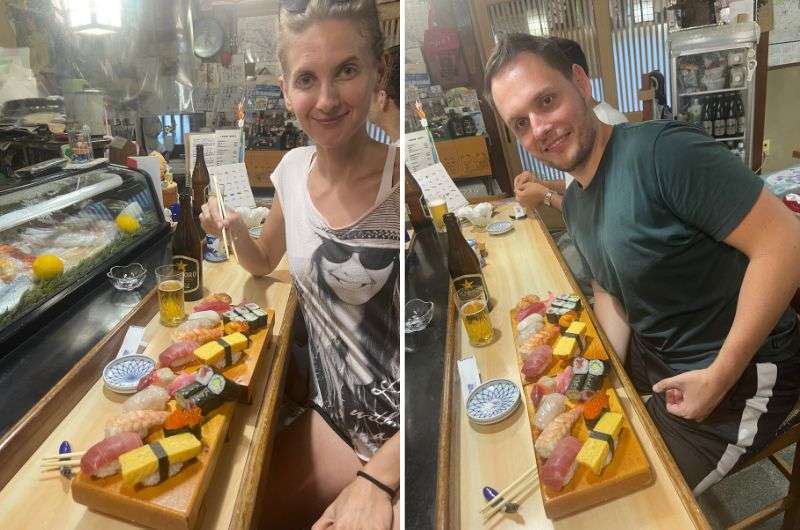
Tokyo Sushi in Hakone was great!
Distance from last stop: 9 km (5.5 mi), 15-minute drive (but I suggest going back to your hotel for a shower first!)
Time spent there: As long as the sushi keeps coming!
Today’s diner restaurant is worthy of being mentioned as a stop on your itinerary—Tokyo Sushi is a mini restaurant in Hakone, serving—obviously—sushi. But it’s the best quality sushi I’ve ever seen and tasted!
The food at Tokyo Sushi felt authentically Japanese, made by a chef with 40+ years of experience, and it was unlike anything I’ve ever experienced before. Make reservations to secure a spot; the restaurant is small and very popular. So popular that you feel like a VIP just because you got in.
And that marks the end of your 2 days exploring Hakone. Now what? Have you planned to spend enough time on the Kyoto–Nara–Osaka loop? I recommend 4 days for this trio (3 if you skip Osaka, but whatever you do, spend 3 days in Kyoto and Nara. Temples and deer may not sound like much, but it was miles above places like… oh, I don’t know… Tokyo.
FAQs
How many days do you need in Hakone?
You'll want at least two days in Hakone to soak up all the sights without rushing. If you're eyeing a hike up Mt. Fuji, pencil in extra days just for that. I also don’t recommend Hakone as a day trip—there’s too much you’d have to skip.
Can you see Mt. Fuji from Hakone?
Absolutely, Hakone offers some fabulous spots to stare at Mt. Fuji, but remember, it's a game of cloud hide-and-seek, so pick your viewing times wisely—winter is best for clear skies, the summer semi-sucks. Lake Ashi and the Owakudani area are popular spots for catching a glimpse of the iconic peak. If you’re so serious about Mt. Fuji that you want to sleep with him/her, note that you can see Mt. Fuji even from some of the hotels in Hakone, like Ryuguden and Hakone Green Plaza Hotel. Imagine soaking in an onsen, with Mt. Fuji watching over you… wait, that’s creepy!
How long from Hakone to Mt. Fuji?
While you're practically neighbors, traveling from Hakone to the base of Mt. Fuji can take up to 1.5 hours by car, depending on which part of Fuji you're aiming for. For example, to Kitaguchi Hongu Fuji Sengen Shrine, traditionally the starting point for climbing Mt. Fuji, is 1 hour from Hakone. But the closest city that can be considered at the base of Mt. Fuji is Gotemba, just 30 minutes from Hakone. If you’re hoping to actually hike Mt. Fuji, the most popular starting point, Subaru 5th Station, is 1.5 hours from Hakone.
How do I get to Hakone from Tokyo?
The best way to get from Tokyo to Hakone is by train. Hakone’s main train station is called Hakone Yumoto. You can take a Shinkansen (with the JR Pass) from Tokyo or Ueno Station to Odawara Station, taking about 35 minutes to Odawara. Alternatively, with the Hakone Free Pass, the Odakyu Electric Railway from Shinjuku Station to Odawara Station typically takes about 85 minutes. Then you need to transfer from Odawara to Hakone Yumoto for the last 15 minutes of the journey. If you drive from Tokyo to Hakone, it’ll take you about 1.5–2 hours.
Can I do Mt. Fuji in one day?
If by “do” you mean hike, then yes, you can tackle Mt. Fuji in a day if you're fit and fast, but remember, the hiking season is July and August only. There are 4 main trails leading up Mt. Fuji taking anywhere from 5–8 hours to ascend and up to 3 hours to descend. You can hike up and down Mt. Fuji in a single day, but it’s a long day! Many people choose to overnight in one of the huts and time their summit for sunrise the next day. The most popular and shortest trail is Yoshida Trail, accessing Mt. Fuji from the north at Subaru 5th Station.
Does Hakone FreePass include cable car route?
The Hakone Free Pass includes unlimited rides on the Hakone Ropeway (the one that takes you up to Owakudani) and the Hakone Tozan Cable Car but does not cover the Komagatake Ropeway above Lake Ashi.
This post contains affiliate links. I earn a small commission if you make bookings through my links, at no additional cost to you. Thank you for your support!
Overview of Hakone itinerary for 2 days + map
Day 1 of Hakone itinerary: Basically a Mt. Fuji itinerary
Where we stayed at Hakoe - How to save money
Day 2 of the Hakone itinerary: Hikes, volcanoes, and pirate ships
How many days do you need in Hakone?
Can you see Mt. Fuji from Hakone?
How long from Hakone to Mt. Fuji?


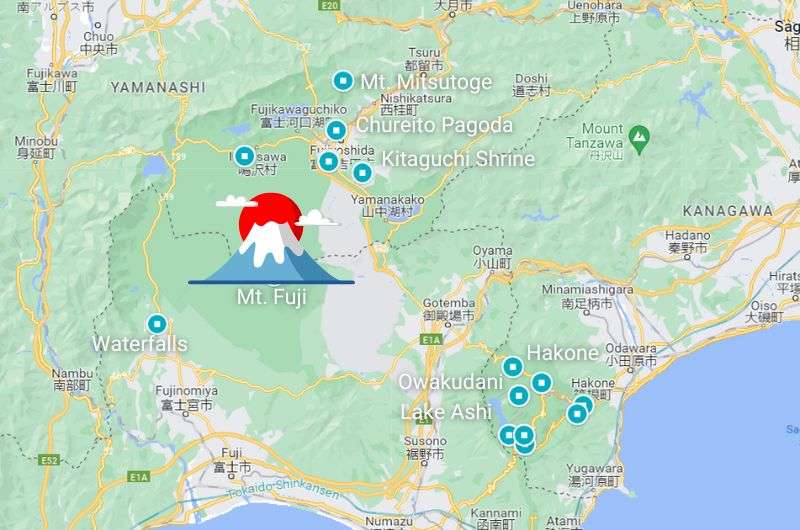
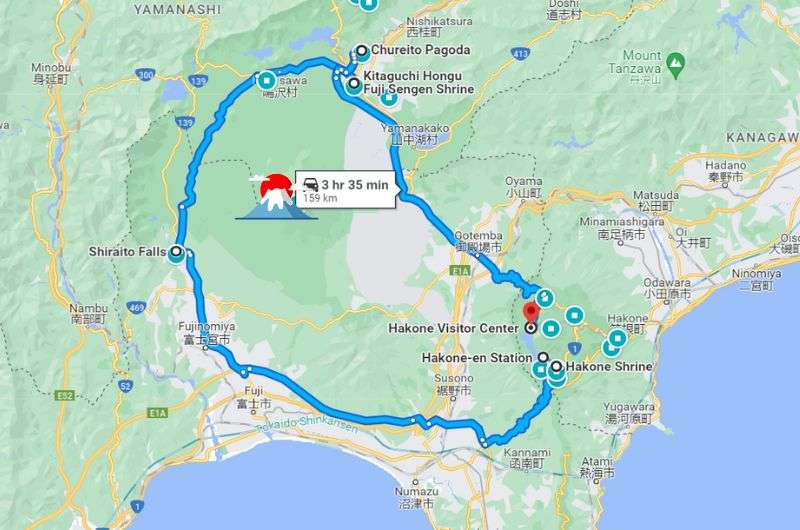
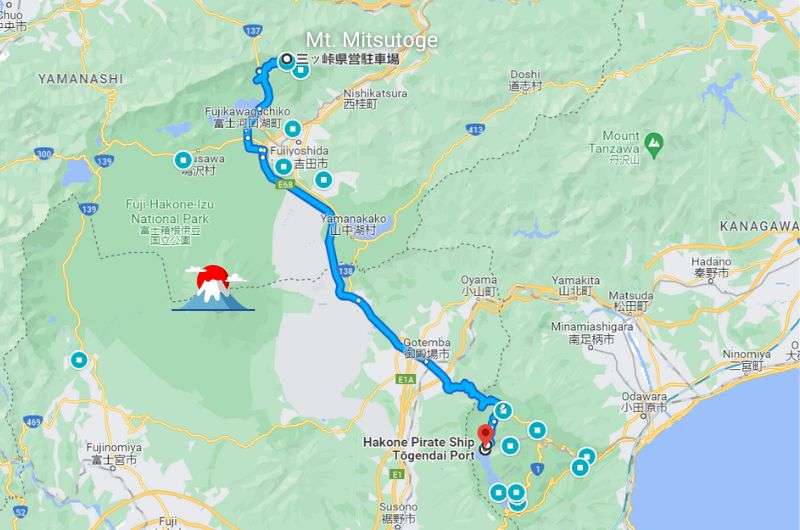
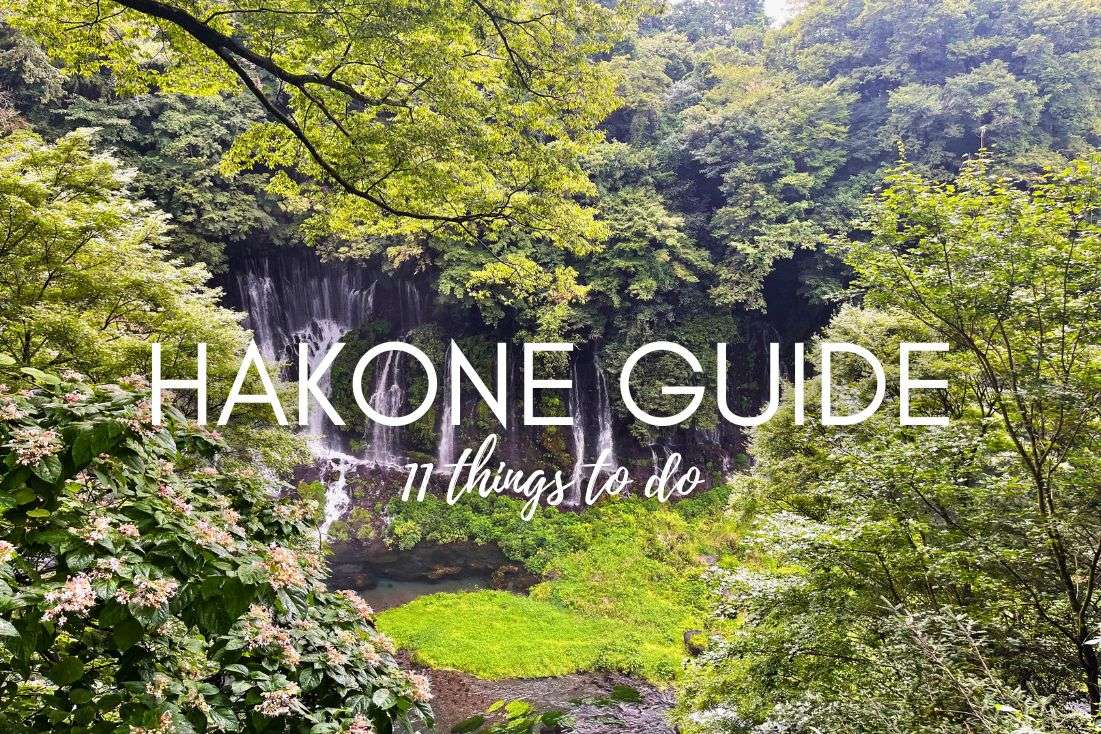
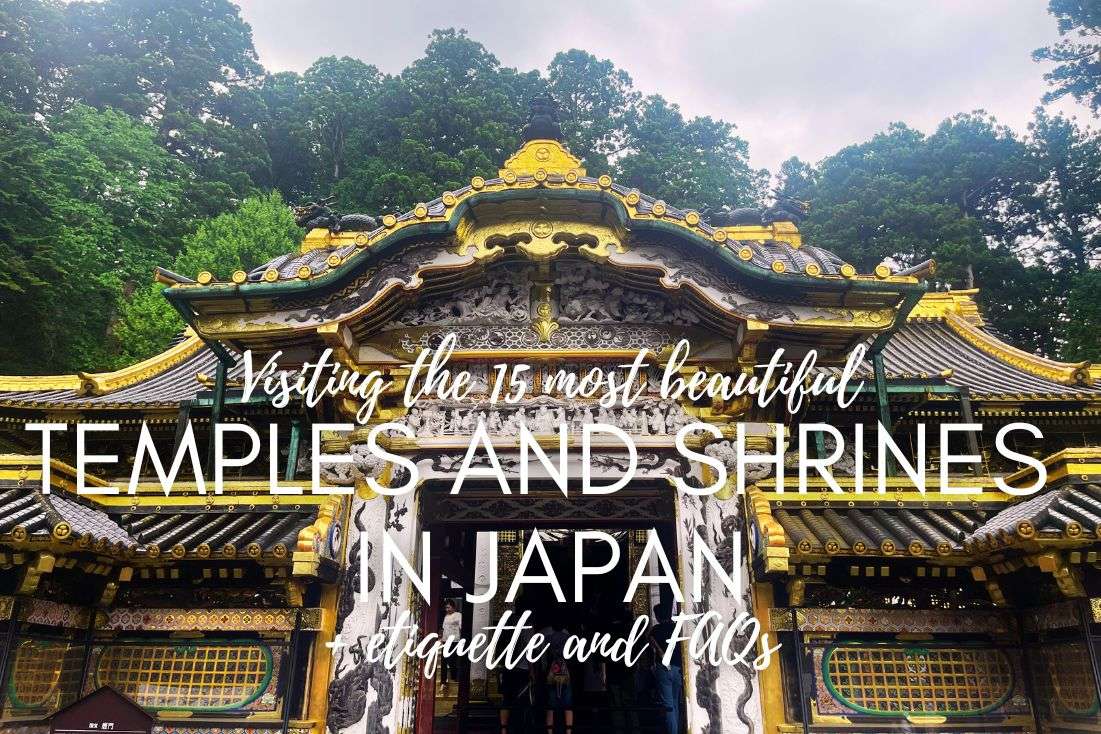
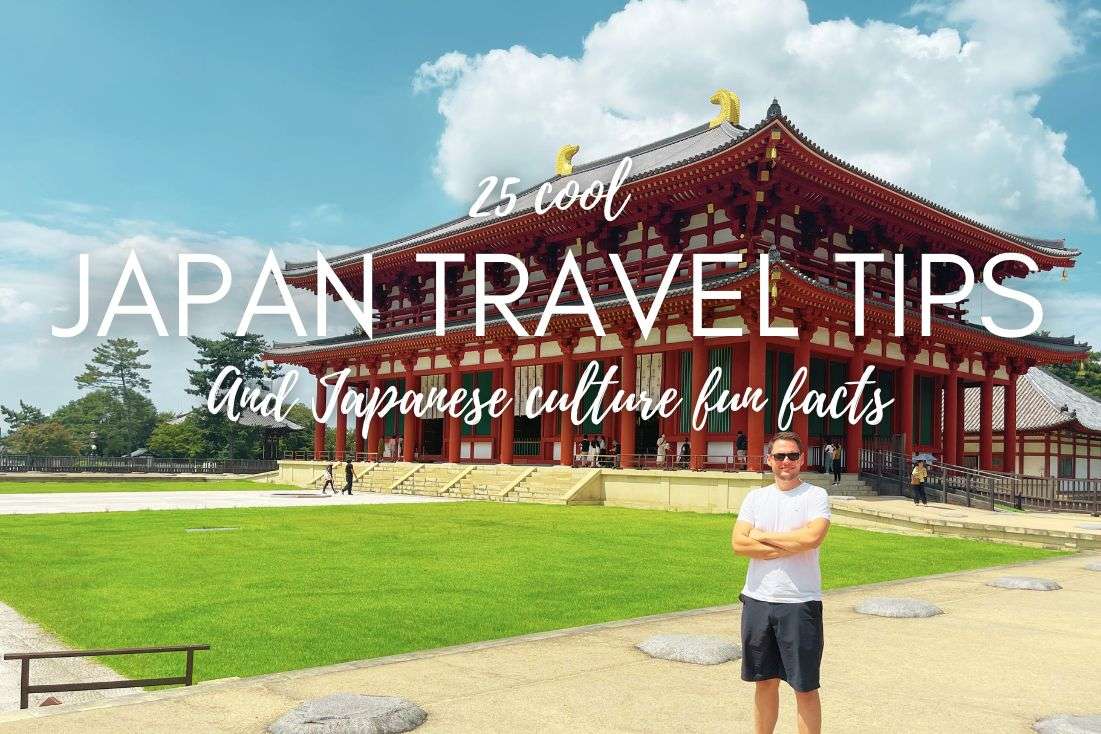





Comments | Thoughts? Give us a shout!